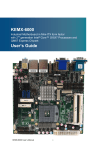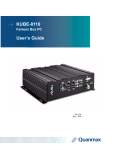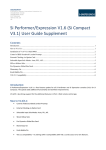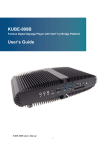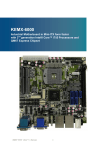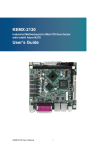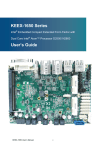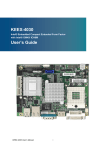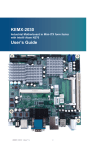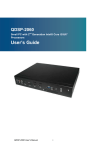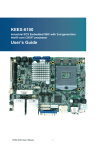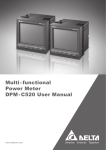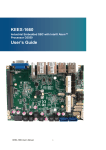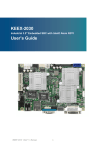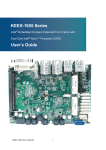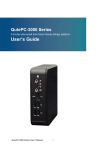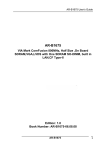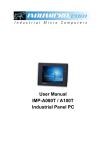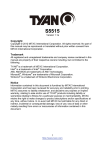Download KEMX-600A User Manual
Transcript
KEMX-600A
Wide Temperature Industrial Motherboard in Mini-ITX
form factor with 2nd generation Intel® Core™ i3/i5/i7
Processors and QM67 Express Chipset
User’s Guide
KEMX-600A User’s Manual
I
Contact Info:
Quanmax Inc.
4F, No. 415, Ti-Ding Blvd. Sec. 2NeiHu District,
Taipei 114Taiwan
Tel: +886-2-2799-2789
Fax: +886-2-2799-7399
Visit our site at:
www.quanmax.com
© 2015 Quanmax Inc. All rights reserved.
The information in this user’s guide is provided for reference only. Quanmax does not assume any
liability arising out of the application or use of the information or products described herein. This user’s
guide may contain or reference information and products protected by copyrights or patents and does
not convey any license under the patent rights of Quanmax, nor the rights of others.
Quanmax is a registered trademark of Quanmax. All trademarks, registered trademarks, and trade
names used in this user’s guide are the property of their respective owners. All rights reserved. This
user’s guide contains information proprietary to Quanmax. Customers may reprint and use this user’s
guide in other publications. Customers may alter this user’s guide and publish it only after they remove
the Quanmax name, cover, and logo.
Quanmax reserves the right to make changes without notice in product or component design as
warranted by evolution in user needs or progress in engineering or manufacturing technology.
Changes which affect the operation of the unit will be documented in the next revision of this user’s
guide.
KEMX-600A User’s Manual
II
Content
Content
Content....................................................................................................................... 3
Figures ....................................................................................................................... 5
Tables......................................................................................................................... 6
Safety Instructions...................................................................................................... 9
Before You Begin......................................................................................... 9
When Working Inside a Computer............................................................... 9
Preventing Electrostatic Discharge............................................................ 10
Preface..................................................................................................................... 12
How to Use This Guide.............................................................................. 12
Unpacking.................................................................................................. 12
Regulatory Compliance Statements .......................................................... 12
Warranty Policy ......................................................................................... 13
Maintaining Your Computer ....................................................................... 14
Chapter 1 Introduction ........................................................................................... 17
Overview ................................................................................................... 17
Product Specifications ............................................................................... 18
System Block Diagram .............................................................................. 20
Mechanical Dimensions............................................................................. 21
Chapter 2 Hardware Settings ................................................................................ 22
Overview ................................................................................................... 22
Jumper Settings and Pin Definitions.......................................................... 23
Jumper Settings ...................................................................................... 25
Rear Panel Pin Assignments ................................................................... 28
Main Board Pin Assignments................................................................... 31
Chapter 3 System Installation ................................................................................ 45
Expansion Interfaces ................................................................................. 45
Memory Module Installation....................................................................... 46
Chapter 4 AMI BIOS Setup.................................................................................... 47
Overview ................................................................................................... 47
Main Menu................................................................................................. 48
Advanced Menu......................................................................................... 48
Boot Menu ................................................................................................. 59
Security Menu............................................................................................ 60
Save & Exit Menu ...................................................................................... 61
KEMX-600A User’s Manual
3
Content
Chapter 5
Driver Installation................................................................................. 63
Appendix A DIO (Digital I/O) Sample Code............................................................ 64
Appendix B WatchDog Timer Sample Code .......................................................... 66
KEMX-600A User’s Manual
4
Figures
Figures
Figure 1 Block Diagram ............................................................................. 20
Figure 2 Mechanical Dimensions ............................................................... 21
Figure 3 Jumper Connector ....................................................................... 22
Figure 4 Jumper and Connector Locations ................................................ 24
Figure 5 Rear Panel IO .............................................................................. 28
Figure 6 Expansion Interfaces ................................................................... 45
Figure 7 Align the SO-DIMM Memory Module with the onboard socket..... 46
Figure 8 Press down on the SO-DIMM Memory Module to lock it in place 46
KEMX-600A User’s Manual
5
Tables
Tables
Table 1 KEMX-600A Specification.............................................................. 19
Table 2 Jumper List.................................................................................... 25
Table 3 JP1 AT / ATX Mode Selection ........................................................ 25
Table 4 JP2 Signal / Power Selection for COM5 ........................................ 25
Table 5 JP3 Panel Backlight Power Selection for LVDS2........................... 26
Table 6 JP4 Signal / Power Selection for COM6........................................ 26
Table 7 JP5 Panel Backlight Power Selection for LVDS1 .......................... 26
Table 8 JP6 Backlight Power Enable Selection for LVDS1......................... 26
Table 9 JP7 Backlight Power Enable Selection for LVDS2......................... 27
Table 10 JP8 RTC Reset Selection............................................................ 27
Table 11 JP9 SRTC Reset Selection.......................................................... 27
Table 12 JP11 Flash Description Security Over-ride .................................. 27
Table 13 Rear Panel Connector List .......................................................... 28
Table 14 AUDIO1, 3 Stack-up Azalia Audio Phone Jack ............................ 28
Table 15 CN10 LAN1 & USB2.0 Port 0, 1 Connector................................. 28
Table 16 CN11 LAN2 & USB2.0 Port 2,3 Connector.................................. 29
Table 17 CN12 CRT DB-15 & DVI-D Connector ........................................ 29
Table 18 CN13 RS-232 / 422 / 485 Port 1, 2 Connector ............................ 30
Table 19 HDMI Connector.......................................................................... 30
Table 20 ATX1 24-pin ATX Power Input Connector .................................... 31
Table 21 ATX 4-pin ATX Power Input Connector........................................ 31
Table 22 CFD1 CF Type II Connector ........................................................ 32
Table 23 COM3 RS-232 Port 3 Pin Header................................................ 32
Table 24 COM4 RS-232 Port 4 Pin Header................................................ 33
Table 25 COM5 RS-232 Port 5 Pin Header................................................ 33
Table 26 COM6 RS-232 Port 6 Pin Header................................................ 34
Table 27 CN1 SIM Interface Wafer for MPCIE1 ......................................... 34
Table 28 CN2 MPCIE Activity Indication Pin Header.................................. 34
Table 29 CN3 Panel Backlight Wafer for LVDS2 ........................................ 35
Table 30 CN4 Digital Input / Output Pin Header......................................... 35
Table 31 CN5 Panel Backlight Wafer for LVDS1 ........................................ 35
Table 32 CN6 Keyboard & Mouse Wafer ................................................... 36
Table 33 CN7 Azalia Front Audio Pin Header............................................. 36
Table 34 CN8 Right Channel 2W Audio AMP Output Wafer....................... 36
KEMX-600A User’s Manual
6
Tables
Table 35 CN9 Left Channel 2W Audio AMP Output Wafer ......................... 36
Table 36 DIMM1 Primary DDR3 Memory SO-DIMM Socket ...................... 36
Table 37 DIMM2 Secondary DDR3 Memory SO-DIMM Socket ................. 36
Table 38 FAN1 PU FAN Wafer ................................................................... 37
Table 39 System FAN Wafer ...................................................................... 37
Table 40 FP1 Front Panel 1 Pin Header .................................................... 37
Table 41 FP2 Front Panel 2 Pin Heade...................................................... 37
Table 42 IR1 IrDA Pin Header .................................................................... 37
Table 43 LVDS1 Primary 24-bit, 2-channel LVDS Panel Connector........... 38
Table 44 LVDS2 Secondary 24-bit, 2-channel LVDS Panel Connector ...... 38
Table 45 PCIE1 Mini-PCIE Express v1.2 Socket 1 .................................... 39
Table 46 PCIE2 Mini-PCIE Express v1.2 Socket 2 .................................... 40
Table 47 PEG1 PCIE Express x 16 Slot..................................................... 41
Table 48 SATA1 Serial ATA Port0 Connector ............................................. 42
Table 49 SATA2 Serial ATA Port1 Connector ............................................. 42
Table 50 SATA3 Serial ATA Port2 Connector ............................................. 42
Table 51 SATA4 Serial ATA Port3 Connector ............................................. 43
Table 52 SATA5 Serial ATA Port4 Connector ............................................. 43
Table 53 SATA6 Serial ATA Port5 Connector ............................................. 43
Table 54 USB1 USB2.0 Port 4, 5 Pin Header ............................................ 44
Table 55 USB2 USB2.0 Port 6, 7 Pin Header ............................................ 44
Table 56 USB3 USB2.0 Port 8, 9 Pin Header ............................................ 44
Table 57 BIOS Main Menu ......................................................................... 48
Table 58 Advanced Menu........................................................................... 48
Table 59 Advanced Menu – Display Configuration..................................... 49
Table 60 Advanced Menu – Super IO Configuration.................................. 50
Table 61 Advanced Menu – Super IO Configuration – Serial Port 1
Configuration ...................................................................................... 50
Table 62 Advanced Menu – Super IO Configuration – Serial Port 2
Configuration ...................................................................................... 51
Table 63 Advanced Menu – Super IO Configuration – Serial Port 3
Configuration ...................................................................................... 51
Table 64 Advanced Menu – Super IO Configuration –Serial Port 4
Configuration ...................................................................................... 52
Table 65 Advanced Menu – Super IO Configuration –Serial Port 5
Configuration ...................................................................................... 53
Table 66 Advanced Menu – Super IO Configuration –Serial Port 6
Configuration ...................................................................................... 53
KEMX-600A User’s Manual
7
Tables
Table 67 Advanced Menu –Power Management Configuration.................. 54
Table 68 Advanced Menu –SATA Configuration......................................... 55
Table 69 Advanced Menu –AMT Configuration .......................................... 55
Table 70 Advanced Menu – USB Configuration ......................................... 57
Table 71 Advanced Menu – H/W Monitor................................................... 58
Table 72 Advanced Menu – CPU Advanced Configuration ........................ 58
Table 73 Boot Menu ................................................................................... 59
Table 74 Security Menu ............................................................................. 60
Table 75 Save & Exit Menu ........................................................................ 61
KEMX-600A User’s Manual
8
Safety Instructions
Safety Instructions
Before You Begin
Before handling the product, read the instructions and safety guidelines on the
following pages to prevent damage to the product and to ensure your own personal
safety. Refer to the “Advisories” section in the Preface for advisory conventions used
in this user’s guide, including the distinction between Warnings, Cautions, Important
Notes, and Notes.
Always use caution when handling/operating a computer. Only qualified,
experienced, authorized electronics service personnel should access the
interior of a computer. The power supplies produce high voltages and
energy hazards, which can cause bodily harm.
Use extreme caution when installing or removing components. Refer to the
installation instructions in this user’s guide for precautions and procedures.
If you have any questions, please contact Quanmax Post-Sales Technical
Support.
WARNING
High voltages are present inside the chassis when the unit’s power cord is
plugged into an electrical outlet. Turn off system power, turn off the power
supply, and then disconnect the power cord from its source before
removing the chassis cover. Turning off the system power switch does not
remove power to components.
When Working Inside a Computer
Before taking covers off a computer, perform the following steps:
1. Turn off the computer and any peripherals.
2. Disconnect the computer and peripherals from their power sources or
subsystems to prevent electric shock or system board damage. This does not
apply when hot swapping parts.
KEMX-600A User’s Manual
9
Safety Instructions
3.
Follow the guidelines provided in “Preventing Electrostatic Discharge” on the
following page.
4.
Disconnect any telephone or telecommunications lines from the computer.
In addition, take note of these safety guidelines when appropriate:
To help avoid possible damage to system boards, wait five seconds after
turning off the computer before removing a component, removing a system
board, or disconnecting a peripheral device from the computer.
When you disconnect a cable, pull on its connector or on its strain-relief loop,
not on the cable itself. Some cables have a connector with locking tabs. If you
are disconnecting this type of cable, press in on the locking tabs before
disconnecting the cable. As you pull connectors apart, keep them evenly
aligned to avoid bending any connector pins. Also, before connecting a cable,
make sure both connectors are correctly oriented and aligned.
CAUTION
Do not attempt to service the system yourself except as explained in this
user’s guide. Follow installation and troubleshooting instructions closely.
Preventing Electrostatic Discharge
Static electricity can harm system boards. Perform service at an ESD workstation
and follow proper ESD procedure to reduce the risk of damage to components.
Quanmax strongly encourages you to follow proper ESD procedure, which can
include wrist straps and smocks, when servicing equipment.
You can also take the following steps to prevent damage from electrostatic
discharge (ESD):
When unpacking a static-sensitive component from its shipping carton, do not
remove the component’s antistatic packing material until you are ready to install
the component in a computer. Just before unwrapping the antistatic packaging,
be sure you are at an ESD workstation or grounded. This will discharge any
static electricity that may have built up in your body.
When transporting a sensitive component, first place it in an antistatic container
KEMX-600A User’s Manual
10
Safety Instructions
or packaging.
Handle all sensitive components at an ESD workstation. If possible, use
antistatic floor pads and workbench pads.
Handle components and boards with care. Don’t touch the components or
contacts on a board. Hold a board by its edges or by its metal mounting bracket.
Do not handle or store system boards near strong electrostatic, electromagnetic,
magnetic, or radioactive fields.
KEMX-600A User’s Manual
11
Preface
Preface
How to Use This Guide
This guide is designed to be used as step-by-step instructions for installation, and as
a reference for operation, troubleshooting, and upgrades.
NOTE
Driver downloads and additional information are available under
Downloads on our web site: www.quanmax.com.
Unpacking
When unpacking, follow these steps:
1. After opening the box, save it and the packing material for possible future
2.
shipment.
Remove all items from the box. If any items listed on the purchase order
are missing, notify Quanmax customer service immediately.
3.
Inspect the product for damage. If there is damage, notify Quanmax
customer service immediately. Refer to “Warranty Policy” for the return
procedure.
Regulatory Compliance Statements
This section provides the FCC compliance statement for Class A devices.
FCC Compliance Statement for Class A Devices
The product(s) described in this user’s guide has been tested and found to comply
with the limits for a Class A digital device, pursuant to Part 15 of the FCC Rules.
These limits are designed to provide reasonable protection against harmful
interference when the equipment is operated in a commercial environment. This
equipment generates, uses, and can radiate radio frequency energy and, if not
installed and used in accordance with the user’s guide, may cause harmful
interference to radio communications. Operation of this equipment in a residential
KEMX-600A User’s Manual
12
Preface
area (domestic environment) is likely to cause harmful interference, in which case
the user will be required to correct the interference (take adequate measures) at
their own expense.
Changes or modifications not expressly approved by Quanmax could void the user's
authority to operate the equipment.
NOTE
The assembler of a personal computer system may be required to test
the system and/or make necessary modifications if a system is found to
cause harmful interference or to be noncompliant with the appropriate
standards for its intended use.
Warranty Policy
Limited Warranty
Quanmax Inc.’s detailed Limited Warranty policy can be found under Support at
www.quanmax.com. Please consult your distributor for warranty verification.
The limited warranty is void if the product has been subjected to alteration, neglect,
misuse, or abuse; if any repairs have been attempted by anyone other than
Quanmax or its authorized agent; or if the failure is caused by accident, acts of God,
or other causes beyond the control of Quanmax or the manufacturer. Neglect,
misuse, and abuse shall include any installation, operation, or maintenance of the
product other than in accordance with the user’s guide.
No agent, dealer, distributor, service company, or other party is authorized to change,
modify, or extend the terms of this Limited Warranty in any manner whatsoever.
Quanmax reserves the right to make changes or improvements in any product
without incurring any obligation to similarly alter products previously purchased.
Return Procedure
For any Limited Warranty return, please contact Support at www.quanmax.com and
login to obtain a Return Material Authorization (RMA) Number. If you do not have an
account, send an email to support@quanmax.com to apply for one.
All product(s) returned to Quanmax for service or credit must be accompanied by a
Return Material Authorization (RMA) Number. Freight on all returned items must be
prepaid by the customer who is responsible for any loss or damage caused by
common carrier in transit. Returns for Warranty must include a Failure Report for
each unit, by serial number(s), as well as a copy of the original invoice showing the
KEMX-600A User’s Manual
13
Preface
date of purchase.
To reduce risk of damage, returns of product must be in a Quanmax shipping
container. If the original container has been lost or damaged, new shipping
containers may be obtained from Quanmax Customer Service at a nominal cost.
Quanmax owns all parts removed from repaired products. Quanmax uses new and
reconditioned parts made by various manufacturers in performing warranty repairs
and building replacement products. If Quanmax repairs or replaces a product, its
warranty term is not extended.
Shipments not in compliance with this Limited Warranty Return Policy will not be
accepted by Quanmax.
Limitation of Liability
In no event shall Quanmax be liable for any defect in hardware, software, loss, or
inadequacy of data of any kind, or for any direct, indirect, incidental, or
consequential damages in connection with or arising out of the performance or use
of any product furnished hereunder. Quanmax’s liability shall in no event exceed the
purchase price of the product purchased hereunder. The foregoing limitation of
liability shall be equally applicable to any service provided by Quanmax or its
authorized agent.
Maintaining Your Computer
Environmental Factors
Temperature
The ambient temperature within an enclosure may be greater than room
ambient temperature. Installation in an enclosure should be such that the
amount of air flow required for safe operation is not compromised.
Consideration should be given to the maximum rated ambient temperature.
Overheating can cause a variety of problems, including premature aging and
failure of chips or mechanical failure of devices.
If the system has been exposed to abnormally cold temperatures, allow a
two-hour warm-up period to bring it up to normal operating temperature before
turning it on. Failure to do so may cause damage to internal components,
particularly the hard disk drive.
Humidity
High-humidity can cause moisture to enter and accumulate in the system. This
moisture can cause corrosion of internal components and degrade such
KEMX-600A User’s Manual
14
Preface
properties as electrical resistance and thermal conductivity. Extreme moisture
buildup inside the system can result in electrical shorts, which can cause
serious damage to the system.
Buildings in which climate is controlled usually maintain an acceptable level of
humidity for system equipment. However, if a system is located in an unusually
humid location, a dehumidifier can be used to maintain the humidity within an
acceptable range. Refer to the “Specifications” section of this user’s guide for
the operating and storage humidity specifications.
Altitude
Operating a system at a high altitude (low pressure) reduces the efficiency of
the cooling fans to cool the system. This can cause electrical problems related
to arcing and corona effects. This condition can also cause sealed components
with internal pressure, such as electrolytic capacitors, to fail or perform at
reduced efficiency.
Power Protection
The greatest threats to a system’s supply of power are power loss, power spikes,
and power surges caused by electrical storms, which interrupt system operation
and/or damage system components. To protect your system, always properly
ground power cables and one of the following devices.
Surge Protector
Surge protectors are available in a variety of types and usually provide a level
of protection proportional with the cost of the device. Surge protectors prevent
voltage spikes from entering a system through the AC power cord. Surge
protectors, however, do not offer protection against brownouts, which occur
when the voltage drops more than 20 percent below the normal AC line voltage
level.
Line Conditioner
Line conditioners go beyond the over voltage protection of surge protectors.
Line conditioners keep a system’s AC power source voltage at a fairly constant
level and, therefore, can handle brownouts. Because of this added protection,
line conditioners cost more than surge protectors. However, line conditioners
cannot protect against a complete loss of power.
KEMX-600A User’s Manual
15
Preface
Uninterruptible Power Supply
Uninterruptible power supply (UPS) systems offer the most complete protection
against variations on power because they use battery power to keep the server
running when AC power is lost. The battery is charged by the AC power while it
is available, so when AC power is lost, the battery can provide power to the
system for a limited amount of time, depending on the UPS system.
UPS systems range in price from a few hundred dollars to several thousand
dollars, with the more expensive unit s allowing you to run larger systems for a
longer period of time when AC power is lost. UPS systems that provide only 5
minutes of battery power let you conduct an orderly shutdown of the system,
but are not intended to provide continued operation. Surge protectors should be
used with all UPS systems, and the UPS system should be Underwriters
Laboratories (UL) safety approved.
KEMX-600A User’s Manual
16
Chapter 1
Chapter 1
Introduction
Overview
The KEMX-600A is a Mini-ITX form factor wide temperature industrial motherboard
combining the latest 2nd generation Intel® Core™ i3/i5/i7 processors with the high
integration of the Intel® QM67 chipset. Featured are DDR3 1066/1333 SO-DIMM up
to 16GB, 24-bit LVDS, HDMI, DVI-D, VGA, 2x Gigabit Ethernet, 5x SATA, 1x PCIe x
16, mini PCIe Expansion slot, 2x USB 3.0, 8x USB 2.0, 6x COM ports with Power
Selection, HD audio, keyboard/mouse and CompactFlash.
The KEMX-600A is a compact, high performance industrial motherboard that is ideal
for a variety of applications.
Checklist
Driver/ Manual CD
Quick Installation Guide
I/O Shield
KEMX-600A Mini-ITX main board
SATA cable (7-pin connector with lock, L=46cm)
COM cable
Features
2nd Generation Intel® Core™ i3/i5/i7 Processors
Intel® QM67Express Chipset
1x VGA, 1x DVI-D, 1x HDMI, and 2x 24-bit dual-channel LVDS
2x Dual Channel DDR3 SO-DIMM Socket, total up to 16 GB
1x PCIe x16 slot, 2x Mini PCIe,1x Compact Flash Socket
5x SATA, 2x USB 3.0, 8x USB 2.0, 6 x COM Ports
2x GbE, iAMT 7.0 supported
Watchdog Timer, Hardware Monitor
Wide operating temperature range: -20ºC ~ 70ºC
KEMX-600A User’s Manual
17
Chapter 1
Product Specifications
Model Name
KEMX-600A
CPU Support
2nd Generation Intel® Core™ i3/i5/i7 Processors
Chipset
Intel® QM67 Express Chipset
2x DDR3 1066/1333 SO-DIMM Socket, up to 16GB
Memory
BIOS
AMI PnP Flash BIOS
iAMT7.0 supported
Sandy Bridge Integrated graphics core.
Display from Cougar Point
1x DB-15 connector
Display
1x DVI-D connector
1x HDMI connector
2x SPWG connectors for 2x LVDS supported
LVDS backlight control supported
LAN
2x RJ-45, Gigabit Ethernet
Intel® GbE PHY 82579 and 82574 GbE controller
Realtek ALC888 HD audio codec.
1x audio stack connector for Line-Out, Line-In and Mic-In
Audio
1x S/PDIF connector on rear I/O for S/PDIF out supported
1x header for front panel audio supported
2x audio amplifier onboard
2x connectors for Right/Left speaker out
Storage supported
4x SATA connectors supported
Raid 0/1/5/10 supported
1x CF socket supported
2x USB3.0 ports support
2x ports stack with two RJ-45 connectors
Peripheral Support
8x USB2.0 ports support
2x ports stack with two RJ-45 connectors
6x ports via 4x headers for internal.
1x header for 8-bits DIO supported
4-bits Input and 4-bits Output
1x wafer connector for PS/2 Keyboard/Mouse
6x COM ports supported
2x DB-9 male connectors for COM1, COM2
KEMX-600A User’s Manual
18
Chapter 1
COM1 & COM2 with RS-232/422/485 supported
4x headers for COM3 ~ COM6
COM3 & COM4 with +12V & +5V supported, select by jumper
COM5 & COM6 with RS-232 only
1x header for IrDA supported
Buzzer onboard
TPM1.2 supported
2x fans supported
1x 3-pin FAN for CPU
1x 3-pin FAN for system
Fans speed control supported
1x ATX-24P for power input
Power
1x ATX-4P for CPU core power
AT/ATX supported
Battery
ACPI
1x vertical battery socket
Lithium, 3V
ACPI supported
2x Mini PCIe slots supported
Expansion
1x 2G/3G SIM card module supported
1x PCIex16 slot supported
Watchdog Timer
1-255 step
Supply voltages detection
Hardware Monitor
CPU and system temperature detection
CPU and system fan speed detection
Dimensions
Mini-ITX (170 x 170 mm)
Operation Temp: -20ºC - 70ºC
Environmental Factors Storage Temp.: -40ºC - 85ºC
Humidity: 0% - 90%
Certifications
CE, FCC Class A
Table 1 KEMX-600A Specification
KEMX-600A User’s Manual
19
Chapter 1
System Block Diagram
Figure 1 Block Diagram
KEMX-600A User’s Manual
20
Chapter 1
Mechanical Dimensions
*A-ø: 3.51mm
*B-ø: 2.6mm
Figure 2 Mechanical Dimensions
KEMX-600A User’s Manual
21
Chapter 2
Chapter 2
Hardware Settings
Overview
This chapter provides the definitions and locations of jumpers, headers, and
connectors.
Jumpers
The product has several jumpers which must be properly configured to ensure
correct operation.
Figure 3 Jumper Connector
For a three-pin jumper (see Figure 3), the jumper setting is designated “1-2” when
the jumper connects pins 1 and 2. The jumper setting is designated “2-3” when pins
2 and 3 are connected and so on. You will see that one of the lines surrounding a
jumper pin is thick, which indicates pin No.1.
To move a jumper from one position to another, use needle-nose pliers or tweezers
to pull the pin cap off the pins and move it to the desired position.
KEMX-600A User’s Manual
22
Chapter 2
Jumper Settings and Pin Definitions
For jumper and connector locations, please refer to the diagrams below.
KEMX-600A User’s Manual
23
Chapter 2
Figure 4 Jumper and Connector Locations
KEMX-600A User’s Manual
24
Chapter 2
Jumper Settings
To ensure correct system configuration, the following section describes how to set
the jumpers to enable/disable or change functions. For jumper descriptions, please
refer to the table below.
Table 2 Jumper List
Label
JP1
JP2
JP3
JP4
JP5
JP6
JP7
JP8
JP9
JP11
Function
AT / ATX Mode Selection
Signal / Power Selection for COM5
Panel & Backlight Power Selection for LVDS2
Signal / Power Selection for COM6
Panel & Backlight Power Selection for LVDS1
Backlight Power Enable Selection for LVDS1
Backlight Power Enable Selection for LVDS2
RTC Reset Selection
SRTC Reset Selection
Flash Description Security Over-ride
Table 3 JP1 AT / ATX Mode Selection
Jumper
Status
1-2 Short ATX Mode
2-3 Short AT Mode
Pitch: 2.54mm [YIMTEX3321*02SAGR (6T)]
1
2
3
Table 4 JP2 Signal / Power Selection for COM5
Jumper
1
9
2
10
KEMX-600A User’s Manual
1
Setting
1-3 Short
3-5 Short
5-7 Short
Function
Pin 1 = +12V
Pin 1 = +5V
Pin 1 = +5V
7-9 Short
Pin 1 = DCD
2-4 Short
Pin 9 = +12V
4-6 Short
Pin 9 = +5V
2
6-8 Short
Pin 9 = +5V
8-10 Short
Pin 9 = RI
Pitch: 2.54mm [YIMTEX 3362*05SANGR]
25
Chapter 2
Table 5 JP3 Panel Backlight Power Selection for LVDS2
1
2
5
6
Jumper
1
Setting
Status
1-3
Backlight Power = +12V
3-5
Backlight Power = +5V
2
2-4
Panel Power = +3.3V
4-6
Panel Power = +5V
Pitch: 2.54mm [YIMTEX 3362*03SAGR]
Table 6 JP4 Signal / Power Selection for COM6
Jumper
1
2
9
10
Setting
Function
1-3 Short
Pin 1 = +12V
3-5 Short
Pin 1 = +5V
1
5-7 Short
Pin 1 = +5V
7-9 Short
Pin 1 = DCD
2-4 Short
Pin 9 = +12V
4-6 Short
Pin 9 = +5V
2
6-8 Short
Pin 9 = +5V
8-10 Short
Pin 9 = RI
Pitch: 2.54mm [YIMTEX 3362*05SANGR]
Table 7 JP5 Panel Backlight Power Selection for LVDS1
Jumper
1
2
5
6
1
2
Setting
1-3
3-5
2-4
4-6
Status
Backlight Power = +12V
Backlight Power = +5V
Panel Power = +3.3V
Panel Power = +5V
Pitch: 2.54mm [YIMTEX 3362*03SAGR]
Table 8 JP6 Backlight Power Enable Selection for LVDS1
1
2
5
6
Jumper
Setting
Status
1-3
Backlight Enable Voltage = +3.3V
1
3-5
Backlight Enable Voltage = +5V
2-4
Active High
2
4-6
Active Low
Pitch: 2.0mm [PINREX 222-97-03GBB1]
KEMX-600A User’s Manual
26
Chapter 2
Table 9 JP7 Backlight Power Enable Selection for LVDS2
1
2
5
6
Jumper
Setting
Status
1-3
Backlight Enable Voltage = +3.3V
1
3-5
Backlight Enable Voltage = +5V
2-4
Active High
2
4-6
Active Low
Pitch: 2.0mm[PINREX 222-97-03GBB1]
Table 10 JP8 RTC Reset Selection
Jumper
Status
1-2 Open
Normal Operation
1-2 Short
Clear RTC CMOS
Pitch: 2.54mm [YIMTEX 3321*02SAGR (6T)]
1
2
Table 11 JP9 SRTC Reset Selection
1
2
Jumper
Status
1-2 Open
Normal Operation
1-2 Short
Clear ME Registers
Pitch: 2.54mm [YIMTEX 3321*02SAGR (6T)]
Table 12 JP11 Flash Description Security Over-ride
1
2
KEMX-600A User’s Manual
Jumper
Status
1-2 Open
Disable
2-3 Short
Enable
Pitch: 2.54mm [YIMTEX 3321*03SAGR (6T)]
27
Chapter 2
Rear Panel Pin Assignments
Figure 5 Rear Panel IO
Table 13 Rear Panel Connector List
Label
AUDIO1
CN10
CN11
CN12
CN13
CN14
HDMI1
Function
3 Stack-up Azalia Audio Phone Jack
LAN1 & USB2.0 Port 0,1 Connector
LAN2 & USB2.0 Port 2,3 Connector
CRT DB-15 & DVI-D Connector
RS-232 / 422 / 485 Port 1, 2 Connector
Optical S/PDIF Output Connector
HDMI Connector
Table 14 AUDIO1, 3 Stack-up Azalia Audio Phone Jack
Signal Name
BLUE
LINE IN
GREEN
LINE OUT
PINK
MIC IN
[Foxconn JA33331-H11P-4F]
Table 15 CN10 LAN1 & USB2.0 Port 0, 1 Connector
Pin
Signal
Pin
1
MDI[0]+
9
2
MDI[0]10
3
MDI[1]+
11
4
MDI[1]12
5
MDI[2]+
13
6
MDI[2]14
7
MDI[3]+
15
8
MDI[3]16
[UDE RU1-161F9WGF (XB)]
KEMX-600A User’s Manual
28
Signal
+USBVCC
USB_AUSB_A+
GND
+USBVCC
USB_BUSB_B+
GND
Chapter 2
Table 16 CN11 LAN2 & USB2.0 Port 2,3 Connector
Pin
Signal
Pin
1
MDI[0]+
9
2
MDI[0]10
3
MDI[1]+
11
4
MDI[1]12
5
MDI[2]+
13
6
MDI[2]14
7
MDI[3]+
15
8
MDI[3]16
[UDE RU1-161F9WGF (XB)]
Signal
+USBVCC
USB_AUSB_A+
GND
+USBVCC
USB_BUSB_B+
GND
Note烉LAN LED Configuration
1.
Left (Link) LED烉Green / Orange
Link 1000 Î Orange LED on
Link 100 Î Green LED on
2.
Link 10 or No Link Î LED off
Right (Active) LED烉Yellow
Activity Î Yellow LED blink
Table 17 CN12 CRT DB-15 & DVI-D Connector
Signal Name
Pin
Pin
Signal Name
Red
V1
V2
Green
Blue
V3
V4
NC
GND
V5
V6
GND
GND
V7
V8
GND
+5V
V9
V10
GND
NC
V11
V12
DDC_DATA
HSYNC
V13
V14
VSYNC
DDC_CLK
V15
Signal Name
Pin
Pin
Signal Name
TX21
2
TX2+
GND
3
4
NC
NC
5
6
DDC_CLK
DDC_DATA
7
8
NC
TX19
10
TX1+
GND
11
12
NC
NC
13
14
+5V
GND
15
16
HTPLG
TX017
18
TX0+
GND
19
20
NC
NC
21
22
GND
TXC+
23
24
TXCGND
C
[FAN YING G205D2C01012PHN]
KEMX-600A User’s Manual
29
Chapter 2
Table 18 CN13 RS-232 / 422 / 485 Port 1, 2 Connector
Port
Pin
RS-232
RS-422
1
B1
B2
B3
B4
B5
B6
B7
B8
B9
DCD
RXD
TXD
DTR
GND
DSR
RTS
CTS
RI
TXRX+
TX+
RXGND
NA
NA
NA
NA
Port
Pin
RS-232
RS-422
A1
DCD
TXA2
RXD
RX+
A3
TXD
TX+
A4
DTR
RX2
A5
GND
GND
A6
DSR
NA
A7
RTS
NA
A8
CTS
NA
A9
RI
NA
[FAN YING D20HB1102112PN]
Half Duplex
RS-485
DATANA
DATA+
NA
GND
NA
NA
NA
NA
Half Duplex
RS-485
DATANA
DATA+
NA
GND
NA
NA
NA
NA
Note烉
烉RS-232 / 422 / 485 can be selected in BIOS setup.
Table 19 HDMI Connector
Pin
Signal
1
TMDS Data2+
2
Ground
3
TMDS Data2–
4
TMDS Data1+
5
Ground
6
TMDS Data1–
7
TMDS Data0+
8
Ground
9
TMDS Data0–
10
TMDS Clock+
11
Ground
12
TMDS Clock–
13
Reserved
14
Reserved
15
DDC_CLK
16
DDC_DATA
17
Ground
18
+5 V Power
19
Hot Plug Detect
[ARGOSY HDMIV-A1915-DK2R]
KEMX-600A User’s Manual
30
Full Duplex
RS-485
TXRX+
TX+
RXGND
NA
NA
NA
NA
Full Duplex
RS-485
TXRX+
TX+
RXGND
NA
NA
NA
NA
Chapter 2
Main Board Pin Assignments
Table 20 ATX1 24-pin ATX Power Input Connector
Pin
Signal
Pin
Signal
1
+3.3V
13
+3.3V
2
+3.3V
14
NC
3
GND
15
GND
4
+5V
16
PS_ON
5
GND
17
GND
6
+5V
18
GND
7
GND
19
GND
8
POWER OK
20
NC
9
+5VSB
21
+5V
10
+12V
22
+5V
11
+12V
23
+5V
12
+3.3V
24
GND
Pitch: 4.2mm [YIMTEX 576MWA2*12STR]
Table 21 ATX 4-pin ATX Power Input Connector
Pin
Signal Name
1
GND
2
GND
3
+12V
4
+12V
Pitch: 4.2mm[YIMTEX576MWA2*02STR]
KEMX-600A User’s Manual
31
Chapter 2
Table 22 CFD1 CF Type II Connector
Signal Name Pin
GND
1
IDE Data 3
2
IDE Data 4
3
IDE Data 5
4
IDE Data 6
5
IDE Data 7
6
IDE Chip select
7
1#
GND
8
GND
9
GND
10
GND
11
GND
12
+5V
13
GND
14
GND
15
GND
16
GND
17
SDA2
18
IDE Address 1 19
IDE Address 0 20
IDE Data 0
21
IDE Data 1
22
IDE Data 2
23
IOIS16#
24
GND
25
[SUNLIT 60303020]
Pin
26
27
28
29
30
31
Signal Name
GND
IDE Data 11
IDE Data 12
IDE Data 13
IDE Data 14
IDE Data 15
32
IDE Chip select 3#
33
34
35
36
37
38
39
40
41
42
43
44
45
46
47
48
49
50
GND
IDEIOR#
IDEIOW#
+5V
IDEIRQ
+5V
PCSEL
NC
Reset IDE
IDEIORDY
DREQ
DACK#
IDE activity
PDIAG#
IDE Data 8
IDE Data 9
IDE Data 10
GND
Table 23 COM3 RS-232 Port 3 Pin Header
1
9
KEMX-600A User’s Manual
2
Pin
Signal
1
DCD, Data carrier detect
2
RXD, Receive data
3
TXD, Transmit data
4
DTR, Data terminal ready
5
GND, ground
6
DSR, Data set ready
7
RTS, Request to send
8
CTS, Clear to send
9
RI, Ring indicator
10
NC, Key
Pitch: 2.54mm [YIMTEX 3362*05SANGR-10]
32
Chapter 2
Table 24 COM4 RS-232 Port 4 Pin Header
1
2
9
Pin
Signal
1
DCD, Data carrier detect
2
RXD, Receive data
3
TXD, Transmit data
4
DTR, Data terminal ready
5
GND, ground
6
DSR, Data set ready
7
RTS, Request to send
8
CTS, Clear to send
9
RI, Ring indicator
10
NC, Key
Pitch: 2.54mm [YIMTEX 3362*05SANGR-10]
Table 25 COM5 RS-232 Port 5 Pin Header
1
2
9
Pin
Signal
1
DCD, Data carrier detect/ +12V / +5V *
2
RXD, Receive data
3
TXD, Transmit data
4
DTR, Data terminal ready
5
GND, ground
6
DSR, Data set ready
7
RTS, Request to send
8
CTS, Clear to send
9
RI, Ring indicator/ +12V / +5V *
10
NC, Key
Pitch: 2.54mm [YIMTEX3362*05SANGR-10]
*烉
烉Selected by JP2
KEMX-600A User’s Manual
33
Chapter 2
Table 26 COM6 RS-232 Port 6 Pin Header
1
2
9
Pin
Signal
1
DCD, Data carrier detect/ +12V / +5V *
2
RXD, Receive data
3
TXD, Transmit data
4
DTR, Data terminal ready
5
GND, ground
6
DSR, Data set ready
7
RTS, Request to send
8
CTS, Clear to send
9
RI, Ring indicator/ +12V / +5V *
10
NC, Key
Pitch: 2.54mm [YIMTEX 3362*05SANGR-10]
*烉
烉Selected by JP4
Table 27 CN1 SIM Interface Wafer for MPCIE1
Pin
1
2
Signal Name
UIM_PWR
UIM_DATA
3
UIM_RESET
4
UIM_VPP
5
UIM_CLK
6
GND
Pitch: 1.27mm [Pinrex 712-73-06TWB0]
Table 28 CN2 MPCIE Activity Indication Pin Header
1
4
KEMX-600A User’s Manual
Pin
Signal Name
1
MPCIE1_ACT+
2
MPCIE1_ACT3
MPCIE2_ACT+
4
MPCIE2_ACTPitch: 2.54mm [YIMTEX 3321*04SAGR (6T)]
34
Chapter 2
Table 29 CN3 Panel Backlight Wafer for LVDS2
Pin
1
2
3
4
5
6
7
Signal Name
NC
BL_ADJ *
GND
+5V / +12V **
+5V / +12V **
GND
BL_EN***
Pitch: 1.25mm [Townes Enterprise 1250W-07T1-V]
*烉
烉BL_ADJ can be setting from 0V to 5V in BIOS setup.
**烉Backlight Power can be selected by JP3.
***烉BL_EN can be selected by JP7.
Table 30 CN4 Digital Input / Output Pin Header
1
2
9
10
Pin
Signal
Pin
Signal
1
Digital Output 0
2
Digital Input 0
3
Digital Output 1
4
Digital Input 1
5
Digital Output 2
6
Digital Input 2
7
Digital Output 3
8
Digital Input 3
9
+5V
10
GND
Pitch: 2.54mm [YIMTEX 3362*05SANGR]
Table 31 CN5 Panel Backlight Wafer for LVDS1
Pin
Signal Name
1
NC
2
BL_ADJ *
3
GND
4
+5V / +12V **
5
+5V / +12V **
6
GND
7
BL_EN***
Pitch: 1.25mm [Townes Enterprise 1250W-07T1-V]
*烉BL_ADJ can be setting from 0V to 5V in BIOS setup.
**烉Backlight Power can be selected by JP5.
***烉BL_EN can be selected by JP6
KEMX-600A User’s Manual
35
Chapter 2
Table 32 CN6 Keyboard & Mouse Wafer
Pin
Signal Name
1
MSCLK
2
VCC
3
MSDAT*
4
KBDAT
5
GND
6
KBCLK
Pitch: 2.0mm [STM M24266]
Table 33 CN7 Azalia Front Audio Pin Header
1
2
9
10
Pin
Signal
Pin
Signal
1
MIC2-L
2
Audio GND
3
MIC2-R
4
Audio GND
5
Line2-R
6
MIC2_JD
7
Audio GND
8
Key
9
Line2-L
10
Line2_JD
Pitch: 2.54mm [YIMTEX 3362*05SANGR-08]
Table 34 CN8 Right Channel 2W Audio AMP Output Wafer
Pin
Signal Name
1
Speaker+
2
SpeakerPitch: 2.0mm [YIMTEX 503PW1*02STR]
Table 35 CN9 Left Channel 2W Audio AMP Output Wafer
Pin
Signal Name
1
Speaker+
2
SpeakerPitch: 2.0mm [YIMTEX 503PW1*02STR]
Table 36 DIMM1 Primary DDR3 Memory SO-DIMM Socket
Height: 9.2mm [ARGOSY DDRSK-20401-TP9D]
Table 37 DIMM2 Secondary DDR3 Memory SO-DIMM Socket
Height: 5.2mm [ARGOSY DDRSK-20401-TP5B]
KEMX-600A User’s Manual
36
Chapter 2
Table 38 FAN1 PU FAN Wafer
Pin
1
2
3
1
2
3
Signal
GND
+12V*
FAN_RPM
Pitch: 2.54mm [YIMTEX 521AW1*03STR]
*PWM Fan control supported
Table 39 System FAN Wafer
Pin
1
2
3
1
2
3
Signal
GND
+12V*
FAN_RPM
Pitch: 2.54mm [YIMTEX 521AW1*03STR]
*PWM Fan control supported
Table 40 FP1 Front Panel 1 Pin Header
+ 1
RSTBTN
2 +
-
HLED
SPKR
+
-
Pin
Signal
Pin
Signal
1
Reset Button +
2
Speaker +
3
Reset Button 4
NC
5
HDD LED +
6
Internal Speaker7
HDD LED 8
Speaker Pitch: 2.54mm [YIMTEX 3362*04SANGR]
8
7
-
Note烉Internal Buzzer is enabled when Pin6-8 is shorted
Table 41 FP2 Front Panel 2 Pin Heade
+ 1
PLED
2 +
-
PWRBTN
KLOCK
SMD
+
-
9
10 SMC
Pin
Signal
Pin
Signal
1
Power LED +
2
Power Button +
3
NC
4
Power Button 5
Power LED 6
NC
7
Keyboard Lock
8
SMBus Data
9
GND
10
SMBus Clock
Pitch: 2.54mm [YIMTEX 3362*05SANGR]
Table 42 IR1 IrDA Pin Header
1
5
Pin
Signal Name
1
+5V
2
Key
3
IR_Rx
4
GND
5
IR_Tx
Pitch: 2.54mm [YIMTEX 3321*05SAGR (6T)-02]
KEMX-600A User’s Manual
37
Chapter 2
Table 43 LVDS1 Primary 24-bit, 2-channel LVDS Panel Connector
2
1
30
29
Signal Name
Pin Pin
Signal Name
GND
2
1
VDD_EN
+3.3V / +5V*
4
3
+3.3V / +5V*
TxclkB6
5
TxclkATxclkB+
8
7
TxclkA+
GND
10
9
GND
TxoutB012 11
TxoutA0TxoutB0+
14 13
TxoutA0+
TxoutB116 15
TxoutA1TxoutB1+
18 17
TxoutA1+
TxoutB220 19
TxoutA2TxoutB2+
22 21
TxoutA2+
TxoutB324 23
TxoutA3TxoutB3+
26 25
TxoutA3+
GND
28 27
GND
DDC_Clock
30 29
DDC_Data
Pitch: 1.25mm [HIROSE DF13-30DP-1.25(24)]
*烉LVDS1 panel power can be selected by JP5
Table 44 LVDS2 Secondary 24-bit, 2-channel LVDS Panel Connector
2
1
30
29
Signal Name
Pin Pin
Signal Name
GND
2
1
VDD_EN
+3.3V / +5V*
4
3
+3.3V / +5V*
TxclkB6
5
TxclkATxclkB+
8
7
TxclkA+
GND
10
9
GND
TxoutB012 11
TxoutA0TxoutB0+
14 13
TxoutA0+
TxoutB116 15
TxoutA1TxoutB1+
18 17
TxoutA1+
TxoutB220 19
TxoutA2TxoutB2+
22 21
TxoutA2+
TxoutB324 23
TxoutA3TxoutB3+
26 25
TxoutA3+
GND
28 27
GND
DDC_Clock
30 29
DDC_Data
Pitch: 1.25mm [HIROSE DF13-30DP-1.25(24)]
*烉LVDS2 panel power can be selected by JP3.
KEMX-600A User’s Manual
38
Chapter 2
Table 45 PCIE1 Mini-PCIE Express v1.2 Socket 1
Signal
Pin
Pin
Signal
WAKE#
1
2
+3.3VSB
Reserved
3
4
Ground
Reserved
5
6
+1.5V
CLKREQ#
7
8
Reserved
Ground
9
10
Reserved
REFCLK11
12
Reserved
REFCLK+
13
14
Reserved
Ground
15
16
Reserved
LPC_CLK*
17
18
Reserved
LPC_FRAME#*
19
20
W_Disable#
Ground
21
22
PERST#
PERn0
23
24
+3.3VSB
PERp0
25
26
Ground
Ground
27
28
+1.5V
Ground
29
30
SMB_CLK
PETn0
31
32
SMB_DATA
PETp0
33
34
Ground
Ground
35
36
USB_DGround
37
38
USB_D+
+3.3VSB
39
40
Ground
+3.3VSB
41
42
LED_WWAN#
Ground
43
44
LED_WLAN#
NC/ CL_CLK*
45
46
LED_WPAN#
NC/ CL_DATA* 47
48
+1.5V
NC/ CL_RST#* 49
50
Ground
Reserved
51
52
+3.3VSB
Height: 9.0mm [ARGOSY MPCEC-S00F1-TP09]
* (Default NC)
KEMX-600A User’s Manual
39
Chapter 2
Table 46 PCIE2 Mini-PCIE Express v1.2 Socket 2
Signal
Pin
Pin
Signal
WAKE#
1
2
+3.3VSB
Reserved
3
4
Ground
Reserved
5
6
+1.5V
CLKREQ#
7
8
UIM_PWR**
Ground
9
10
UIM_DATA**
REFCLK11
12
UIM_CLK**
REFCLK+
13
14
UIM_RESET**
Ground
15
16
UIM_VPP**
Reserved
17
18
Ground
Reserved
19
20
W_Disable#
Ground
21
22
PERST#
PERn0
23
24
+3.3VSB
PERp0
25
26
Ground
Ground
27
28
+1.5V
Ground
29
30
SMB_CLK
PETn0
31
32
SMB_DATA
PETp0
33
34
Ground
Ground
35
36
USB_DGround
37
38
USB_D+
+3.3VSB
39
40
Ground
+3.3VSB
41
42
LED_WWAN#
Ground
43
44
LED_WLAN#
NC/ LPC_AD0*
45
46
LED_WPAN#
NC/LPC_AD1*
47
48
+1.5V
NC/ LPC_AD2*
49
50
Ground
NC/ LPC_AD3*
51
52
+3.3VSB
Height: 5.5mm [ARGOSY MPCEC-S00F1-TP03]
*烉
烉These pins are connected to CN1 directly.
* : Internal debug only, left these pins open.
(Default NC)
KEMX-600A User’s Manual
40
Chapter 2
Table 47 PEG1 PCIE Express x 16 Slot
Pin
1
2
3
4
5
6
7
8
9
10
11
12
13
14
15
16
17
18
19
20
21
22
23
24
25
26
27
28
29
30
31
32
33
34
35
36
37
38
39
40
41
Side B
Side A
+12V
PRSNT1#
+12V
+12V
Reserved
+12V
Ground
Ground
SMCLK
Reserved
SMDAT Reserved
Ground
Reserved
+3.3V
Reserved
Reserved
+3.3V
+3.3VSB
+3.3V
WAKE#
PERST#
Reserved
Ground
Ground
REFCLK+
HSOP0
REFCLKHSON0
Ground
Ground
HSIP0
PRSNT2#
HSIN0
Ground
Ground
HSOP1
Reserved
HSON1
Ground
Ground
HSIP1
Ground
HSIN1
HSOP2
Ground
HSON2
Ground
Ground
HSIP2
Ground
HSIN2
HSOP3
Ground
HSON3
Ground
Ground
HSIP3
Reserved
HSIN3
PRSNT2#
Ground
Ground
Reserved
HSOP4
Reserved
HSON4
Ground
Ground
HSIP4
Ground
HSIN4
HSOP5
Ground
HSON5
Ground
Ground
HSIP5
Ground
HSIN5
HSOP6
Ground
Pin
42
43
44
45
46
47
48
49
50
51
52
53
54
55
56
57
58
59
60
61
62
63
64
65
66
67
68
69
70
71
72
73
74
75
Side B
HSON6
Ground
Ground
HSOP7
HSON7
Ground
PRSNT2#
Ground
HSOP8
HSON8
Ground
Ground
HSOP9
HSON9
Ground
Ground
HSOP10
HSON10
Ground
Ground
HSOP11
HSON11
Ground
Ground
HSOP12
HSON12
Ground
Ground
HSOP13
HSON13
Ground
Ground
HSOP14
HSON14
Side A
Ground
HSIP6
HSIN6
Ground
Ground
HSIP7
HSIN7
Ground
Reserved
Ground
HSIP8
HSIN8
Ground
Ground
HSIP9
HSIN9
Ground
Ground
HSIP10
HSIN10
Ground
Ground
HSIP11
HSIN11
Ground
Ground
HSIP12
HSIN12
Ground
Ground
HSIP13
HSIN13
Ground
Ground
76
77
78
79
80
Ground
Ground
HSOP15
HSON15
Ground
HSIP14
HSIN14
Ground
Ground
HSIP15
81
PRSNT2#
HSIN15
82
Reserved
Ground
Pitch: 1.0mm [WIN WIN
WPCS-164AN41B22UWL]
KEMX-600A User’s Manual
41
Chapter 2
Table 48 SATA1 Serial ATA Port0 Connector
Pin
Signal Name
1
GND
2
TX+
3
TX4
GND
5
RX6
RX+
7
GND
[FOXCONN LD1807V-S52U]
Table 49 SATA2 Serial ATA Port1 Connector
Pin
Signal Name
1
GND
2
TX+
3
TX4
GND
5
RX6
RX+
7
GND
[FOXCONN LD1807V-S52U]
Table 50 SATA3 Serial ATA Port2 Connector
Pin
Signal Name
1
GND
2
TX+
3
TX4
GND
5
RX6
RX+
7
GND
[FOXCONN LD1807V-S52U]
KEMX-600A User’s Manual
42
Chapter 2
Table 51 SATA4 Serial ATA Port3 Connector
Pin
Signal Name
1
GND
2
TX+
3
TX4
GND
5
RX6
RX+
7
GND
[FOXCONN LD1807V-S52U]
Table 52 SATA5 Serial ATA Port4 Connector
Pin
Signal Name
1
GND
2
TX+
3
TX4
GND
5
RX6
RX+
7
GND
[FOXCONN LD1807V-S52U]
Table 53 SATA6 Serial ATA Port5 Connector
Pin
Signal Name
1
GND
2
TX+
3
TX4
GND
5
RX6
RX+
7
GND
[FOXCONN LD1807V-S52U]
KEMX-600A User’s Manual
43
Chapter 2
Table 54 USB1 USB2.0 Port 4, 5 Pin Header
1
2
3
4
5
6
7
8
10
Pin
Signal Name
Pin
Signal Name
1
+USBVCC
2
+USBVCC
3
USB_A4
USB_B5
USB_A+
6
USB_B+
7
GND
8
GND
9
KEY
10
GND
Pitch: 2.54mm [YIMTEX 3362*05SANGR-09]
Table 55 USB2 USB2.0 Port 6, 7 Pin Header
1
2
3
4
5
6
7
8
10
Pin
Signal Name
Pin
Signal Name
1
+USBVCC
2
+USBVCC
3
USB_A4
USB_B5
USB_A+
6
USB_B+
7
GND
8
GND
9
KEY
10
GND
Pitch: 2.54mm [YIMTEX 3362*05SANGR-09]
Table 56 USB3 USB2.0 Port 8, 9 Pin Header
1
2
3
4
5
6
7
8
10
KEMX-600A User’s Manual
Pin
Signal Name
Pin
Signal Name
1
+USBVCC
2
+USBVCC
3
USB_A4
USB_B5
USB_A+
6
USB_B+
7
GND
8
GND
9
KEY
10
GND
Pitch: 2.54mm [YIMTEX 3362*05SANGR-09]
44
Chapter 3
Chapter 3
System Installation
Expansion Interfaces
mini PCIe x1 slot
CF
Figure 6 Expansion Interfaces
NOTE
When adding or removing expansion cards, make sure that you unplug the
power supply first. Meanwhile, read the documentation for the expansion card
to configure any necessary hardware or software settings for the expansion
card, such as jumpers, switches or BIOS configuration.
KEMX-600A User’s Manual
45
Chapter 3
Memory Module Installation
Carefully follow the steps below in order to install the SO-DIMMs:
1.
To avoid generating static electricity and damaging the SO-DIMM, ground
yourself by touching a grounded metal surface or use a ground strap before you
touch the SO-DIMM.
2.
Do not touch the connectors of the SO-DIMM. Dirt or other residue may cause a
malfunction.
3.
Hold the SO-DIMM with its notch aligned with the memory socket of the board
and insert it at a 30-degree angle into the socket.
Figure 7 Align the SO-DIMM Memory Module with the onboard socket
4.
5.
Fully insert the module into the socket until a “click” is heard.
Press down on the SO-DIMM so that the tabs of the socket lock on both sides
of the module
Figure 8 Press down on the SO-DIMM Memory Module to lock it in place
Removing a SO-DIMM:
To remove the SO-DIMM, use your fingers or a small screwdriver to carefully push
away the tabs that secure either side of the SO-DIMM. Lift it out of the socket.
Make sure you store the SO-DIMM in an anti-static bag. The socket must be
populated with memory modules of the same size and manufacturer.
KEMX-600A User’s Manual
46
Chapter 4
Chapter 4
AMI BIOS Setup
Overview
This chapter provides a description of the AMI BIOS. The BIOS setup menus and
available selections may vary from those of your product. For specific information on
the BIOS for your product, please contact Quanmax.
NOTE: The BIOS menus and selections for your product may vary from
those in this chapter. For the BIOS manual specific to your product, please
contact Quanmax
AMI's ROM BIOS provides a built-in Setup program, which allows the user to modify
the basic system configuration and hardware parameters. The modified data will be
stored in a battery-backed CMOS, so that data will be retained even when the power
is turned off. In general, the information saved in the CMOS RAM will not need to be
changed unless there is a configuration change in the system, such as a hard drive
replacement or when a device is added.
It is possible for the CMOS battery to fail, which will cause data loss in the CMOS
only. If this happens you will need to reconfigure your BIOS settings.
KEMX-600A User’s Manual
47
Chapter 4
Main Menu
The BIOS Setup is accessed by pressing the DEL key after the Power-On Self-Test
(POST) memory test begins and before the operating system boot begins. Once you
enter the BIOS Setup Utility, the Main Menu will appear on the screen. The Main
Menu provides System Overview information and allows you to set the System Time
and Date. Use the “<” and “>” cursor keys to navigate between menu screens.
Table 57 BIOS Main Menu
BIOS SETUP UTILITY
Main
Advanced
BOS Information
Version
Build
Boot
Memory Information
Total Size
Frequency
Save
&
Exit
Set the Date. Use Tab to switch
between Data elements.
0.03
Date 03/16/2011
CPU Information
Intel ® Core ™ i7-2630QM CPU @ 2.00 GHz
Microcode Revision
Processor Cores
System Date
System Time
Security
ÆÅ: Select Screen
ĹĻ: Select Item
Enter: Select
+/-: Change Opt.
F1: General Help
F2: Previous Values
F3: Optimized Defaults
F4: Save and Exit
ESC: Exit
12
4
4096 MB (DDR3)
1333 MHz
[Tue 03/22/2011]
[11:38:22]
Version 2.10.1208. Copyright © 2010 American Megatrends, Inc.
Advanced Menu
Table 58 Advanced Menu
BIOS SETUP UTILITY
Main
Advanced
Full Item for Debug
Onboard LAN1 Controller
Onboard LAN1 Boot
Onboard LAN2 Controller
Onboard LAN2 Boot
Audio Controller
¾
¾
¾
¾
¾
¾
¾
¾
Boot
[Disabled]
[Enabled]
[Disabled]
[Enabled]
[Disabled]
[Enabled]
Display Configuration
Super IO Configuration
Power Management Configuration
SATA Configuration
AMT Configuration
USB Configuration
H/W Monitor
CPU Advanced Configuration
Security
Save
48
Exit
ÆÅ: Select Screen
ĹĻ: Select Item
Enter: Select
+/-: Change Opt.
F1: General Help
F2: Previous Values
F3: Optimized Defaults
F4: Save and Exit
ESC: Exit
Version 2.10.1208. Copyright © 2010 American Megatrends, Inc.
KEMX-600A User’s Manual
&
Chapter 4
Table 59 Advanced Menu – Display Configuration
BIOS SETUP UTILITY
Main
Advanced
Boot
Chipset
Power
Security
Exit
Select which of IGFX/PEG/PCI
Display Configuration
Primary Display
Internal Graphics
Aperture Size
DVMT Pre-Allocated
DVMT Total Gfx Mem
[AUTO]
[AUTO]
[256MB]
[64M]
[256M]
IGFX – Boot Type
Active LVDS
LVDS1 Panel Type
LVDS2 panel Type
LVDS1 Panel Backlight Voltage
LVDS2 Panel backlight Voltage
[VBIOS Default]
[No LVDS]
[VBIOS Default]
[VBIOS Default]
[2.5 V]
[2.5 V]
Graphics device should be
Primary Display or select SG
for Switchable Gfx.
ÆÅ: Select Screen
ĹĻ: Select Item
Enter: Select
+/-: Change Opt.
F1: General Help
F2: Previous Values
F3: Optimized Defaults
F4: Save and Exit
ESC: Exit
Version 2.10.1208. Copyright © 2010 American Megatrends, Inc.
Primary Display
Options: Auto, IGFX, PEG, PCI, SG
Internal Graphics
Options: Auto, Disabled, Enabled
Aperture Size
Options: 128MB, 256MB, 512MB
DVMT Pre-Allocated
Options: 0M, 32M, 64M, 96M, 128M, 160M, 192M, 224M, 256M, 288M, 320M,
352M, 384M, 416M, 448M, 480M, 512M
DVMT Total Gxf Mem
Options: 128M, 256M, MAX
IGFX – Boot Type
Options: VBIOS Default, CRT, DVI, HDMI
Active LVDS
Options: No LVDS, LVDS1, LVDS2
LVDS1 Panel Type
Options: VBIOS Default, 1024x768 18bit 1Ch, 1280x1024 24bit 2Ch, 1366x768
24bit 2Ch, 1920x1080 24bit 2Ch
LVDS2 Panel Type
Options: VBIOS Default, 1024x768 18bit 1Ch, 1280x1024 24bit 2Ch, 1400x1050
24bit 2Ch, 1600x1200 24bit 2Ch
LVDS1 Panel Backlight Voltage
Options: 0.0V, 0.5V, 1.0V, 1.5V, 2.0V, 2.5V, 3.0V, 3.5V, 4.0V, 4.5V, 5.0V
KEMX-600A User’s Manual
49
Chapter 4
LVDS2 Panel Backlight Voltage
Options: 0.0V, 0.5V, 1.0V, 1.5V, 2.0V, 2.5V, 3.0V, 3.5V, 4.0V, 4.5V, 5.0V
Table 60 Advanced Menu – Super IO Configuration
BIOS SETUP UTILITY
Main
Ad v a n c e d
Boot
Chipset
Power
Super IO Configuration
¾
¾
¾
¾
¾
¾
Security
Exit
Set parameters of Serial Port 1
(COM1)
Serial Port 1 Configuration
Serial Port 2 Configuration
Serial Port 3 Configuration
Serial Port 4 Configuration
Serial Port 5 Configuration
Serial Port 6 Configuration
ÆÅ: Select Screen
ĹĻ: Select Item
Enter: Select
+/-: Change Opt.
F1: General Help
F2: Previous Values
F3: Optimized Defaults
F4: Save and Exit
ESC: Exit
Version 2.10.1208. Copyright © 2010 American Megatrends, Inc.
Table 61 Advanced Menu – Super IO Configuration – Serial Port 1 Configuration
BIOS SETUP UTILITY
Main
Ad v a n c e d
Boot
Chipset
Serial Port 1 Configuration
Serial Port
Device Settings
Power
Security
Exit
Enable or Disable Serial Port
(COM)
[Enabled]
IO=3F8h ; IRQ=4;
Change Settings
Serial Port 1 Type
[Auto]
[RS232]
ÆÅ: Select Screen
ĹĻ: Select Item
Enter: Select
+/-: Change Opt.
F1: General Help
F2: Previous Values
F3: Optimized Defaults
F4: Save and Exit
ESC: Exit
Version 2.10.1208. Copyright © 2010 American Megatrends, Inc.
Serial Port
Options: Disabled, Enabled
Change Settings
Options: Auto, IO=3F8h; IRQ=4; IO=3F8h; IRQ=3, 4, 5, 6, 7, 9, 10, 11, 12; IO=2F8h;
IRQ=3, 4, 5, 6, 7, 9, 10, 11, 12; IO=3E8h; IRQ=3, 4, 5, 6, 7, 9, 10, 11, 12; IO=2E8h;
IRQ=3, 4, 5, 6, 7, 9, 10, 11, 12;
Serial Port 1 Type
Options: RS232, 422, 485
KEMX-600A User’s Manual
50
Chapter 4
Table 62 Advanced Menu – Super IO Configuration – Serial Port 2 Configuration
BIOS SETUP UTILITY
Main
Ad v a n c e d
Boot
Chipset
Power
Security
Exit
Enable or Disable Serial Port
(COM)
Serial Port 2 Configuration
Serial Port
Device Settings
[Enabled]
IO=2F8h ; IRQ=3;
Change Settings
Device Mode
Serial Port 2 Type
[Auto]
[Standard Serial Po...]
[RS232]
ÆÅ: Select Screen
ĹĻ: Select Item
Enter: Select
+/-: Change Opt.
F1: General Help
F2: Previous Values
F3: Optimized Defaults
F4: Save and Exit
ESC: Exit
Version 2.10.1208. Copyright © 2010 American Megatrends, Inc.
Serial Port
Options: Disabled, Enabled
Change Settings
Options: Auto, IO=2F8h; IRQ=3; IO=3F8h; IRQ=3, 4, 5, 6, 7, 9, 10, 11, 12; IO=2F8h;
IRQ=3, 4, 5, 6, 7, 9, 10, 11, 12; IO=3E8h; IRQ=3, 4, 5, 6, 7, 9, 10, 11, 12; IO=2E8h;
IRQ=3, 4, 5, 6, 7, 9, 10, 11, 12;
Device Mode
Options: Standard Serial Port Mode; IrDA function, active pulse is 1.6uS.; IrDA
function, active pulse is 3/16 bit time.
Serial Port 2 Type
Options: RS232, 422, 485
Table 63 Advanced Menu – Super IO Configuration – Serial Port 3 Configuration
BIOS SETUP UTILITY
Main
Ad v a n c e d
Boot
Chipset
Serial Port 3 Configuration
Serial Port
Device Settings
Security
[Auto]
ÆÅ: Select Screen
ĹĻ: Select Item
Enter: Select
+/-: Change Opt.
F1: General Help
F2: Previous Values
F3: Optimized Defaults
F4: Save and Exit
ESC: Exit
Version 2.10.1208. Copyright © 2010 American Megatrends, Inc.
KEMX-600A User’s Manual
Exit
Enable or Disable Serial Port
(COM)
[Enabled]
IO=3E8h ; IRQ=7;
Change Settings
Power
51
Chapter 4
Serial Port
Options: Disabled, Enabled
Change Settings
Options: Auto, IO=2E8h; IRQ=7; IO=3F8h; IRQ=3, 4, 5, 6, 7, 9, 10, 11, 12; IO=2F8h;
IRQ=3, 4, 5, 6, 7, 9, 10, 11, 12; IO=3E8h; IRQ=3, 4, 5, 6, 7, 9, 10, 11, 12; IO=2E8h;
IRQ=3, 4, 5, 6, 7, 9, 10, 11, 12;
Table 64 Advanced Menu – Super IO Configuration –Serial Port 4 Configuration
BIOS SETUP UTILITY
Main
Ad v a n c e d
Boot
Chipset
Power
Serial Port 4 Configuration
Serial Port
Device Settings
[Auto]
ÆÅ: Select Screen
ĹĻ: Select Item
Enter: Select
+/-: Change Opt.
F1: General Help
F2: Previous Values
F3: Optimized Defaults
F4: Save and Exit
ESC: Exit
Version 2.10.1208. Copyright © 2010 American Megatrends, Inc.
Serial Port
Options: Disabled, Enabled
Change Settings
Options: Auto, IO=2E0h; IRQ=10; IO=3F8h; IRQ=3, 4, 5, 6, 7, 9, 10, 11, 12;
IO=2F8h; IRQ=3, 4, 5, 6, 7, 9, 10, 11, 12; IO=3E8h; IRQ=3, 4, 5, 6, 7, 9, 10, 11, 12;
IO=2E8h; IRQ=3, 4, 5, 6, 7, 9, 10, 11, 12
KEMX-600A User’s Manual
Exit
Enable or Disable Serial Port
(COM)
[Enabled]
IO=2E8h ; IRQ=10;
Change Settings
Security
52
Chapter 4
Table 65 Advanced Menu – Super IO Configuration –Serial Port 5 Configuration
BIOS SETUP UTILITY
Main
Ad v a n c e d
Boot
Chipset
Power
Security
Exit
Enable or Disable Serial Port
(COM)
Serial Port 5 Configuration
Serial Port
Device Settings
[Enabled]
IO=2F0h ; IRQ=11;
Change Settings
ÆÅ: Select Screen
ĹĻ: Select Item
Enter: Select
+/-: Change Opt.
F1: General Help
F2: Previous Values
F3: Optimized Defaults
F4: Save and Exit
ESC: Exit
[Auto]
Version 2.10.1208. Copyright © 2010 American Megatrends, Inc.
Serial Port
Options: Disabled, Enabled
Change Settings
Options: Auto, IO=2F0h; IRQ=10; IO=3F8h; IRQ=3, 4, 5, 6, 7, 9, 10, 11, 12;
IO=2F8h; IRQ=3, 4, 5, 6, 7, 9, 10, 11, 12; IO=3E8h; IRQ=3, 4, 5, 6, 7, 9, 10, 11, 12;
IO=2E8h; IRQ=3, 4, 5, 6, 7, 9, 10, 11, 12; IO=2F0h; IRQ=3, 4, 5, 6, 7, 9, 10, 11, 12;
IO=2E0h; IRQ=3, 4, 5, 6, 7, 9, 10, 11, 12;
Table 66 Advanced Menu – Super IO Configuration –Serial Port 6 Configuration
BIOS SETUP UTILITY
Main
Ad v a n c e d
Boot
Chipset
Power
Serial Port 6 Configuration
Serial Port
Device Settings
Security
Exit
Enable or Disable Serial Port
(COM)
[Enabled]
IO=2E0h ; IRQ=10;
Change Settings
[Auto]
ÆÅ: Select Screen
ĹĻ: Select Item
Enter: Select
+/-: Change Opt.
F1: General Help
F2: Previous Values
F3: Optimized Defaults
F4: Save and Exit
ESC: Exit
Version 2.10.1208. Copyright © 2010 American Megatrends, Inc.
Serial Port
Options: Disabled, Enabled
Change Settings
Options: Auto, IO=2E8h; IRQ=3; IO=3F8h; IRQ=3, 4, 5, 6, 7, 9, 10, 11, 12; IO=2F8h;
KEMX-600A User’s Manual
53
Chapter 4
IRQ=3, 4, 5, 6, 7, 9, 10, 11, 12; IO=3E8h; IRQ=3, 4, 5, 6, 7, 9, 10, 11, 12; IO=2E8h;
IRQ=3, 4, 5, 6, 7, 9, 10, 11, 12; IO=2F0h; IRQ=3, 4, 5, 6, 7, 9, 10, 11, 12; IO=2E0h;
IRQ=3, 4, 5, 6, 7, 9, 10, 11, 12;
Table 67 Advanced Menu –Power Management Configuration
BIOS SETUP UTILITY
Main
Ad v a n c e d
Boot
Chipset
Power
Power Management Configuration
ACPI Sleep State
Restore AC Power Loss
Resume From S3 By PS/2 Keyboard
Resume From S3 By PS/2 Mouse
Resume By PCIE Device
Resume From S3 By USB Device
Resume By RTC Alarm
[S3 (Suspend to RAM)]
[Power Off]
[Disabled]
[Disabled]
[Disabled]
[Disabled]
[Disabled]
Security
ÆÅ: Select Screen
ĹĻ: Select Item
Enter: Select
+/-: Change Opt.
F1: General Help
F2: Previous Values
F3: Optimized Defaults
F4: Save and Exit
ESC: Exit
Version 2.10.1208. Copyright © 2010 American Megatrends, Inc.
ACPI Sleep State
Options: Suspend Disabled, S1 (CPU Stop Clock), S3 (Suspend to RAM)
Restore AC Power Loss
Options: Power Off, Power On, Last State
Resume From S3 By PS/2 Keyboard
Options: Disabled, Enabled
Resume From S3 By PS/2 Mouse
Options: Disabled, Enabled
Resume By PCIE Device
Options: Disabled, Enabled
Resume From S3 By USB Device
Options: Disabled, Enabled
Resume By RTC Alarm
Options: Disabled, Enabled
KEMX-600A User’s Manual
54
Exit
Select the highest ACPI Sleep
State the System will enter,
when the SUSPEND button is
pressed.
Chapter 4
Table 68 Advanced Menu –SATA Configuration
BIOS SETUP UTILITY
Main
Ad v a n c e d
Boot
Chipset
Power
SATA Controller(s)
SATA Mode Selection
[Enabled]
[IDE]
Serial ATA Port 0
Software Preserve
Serial ATA Port 1
Software Preserve
Serial ATA Port 2
Software Preserve
Serial ATA Port 3
Software Preserve
Serial ATA Port 4
Software Preserve
Serial ATA Port 5
Software Preserve
FIJITSU MH2216 (160.0
SUPPORTED
Empty
Unknown
Empty
Unknown
Empty
Unknown
Empty
Unknown
Empty
Unknown
Security
Exit
Enable or Disable SATA Device.
ÆÅ: Select Screen
ĹĻ: Select Item
Enter: Select
+/-: Change Opt.
F1: General Help
F2: Previous Values
F3: Optimized Defaults
F4: Save and Exit
ESC: Exit
Version 2.10.1208. Copyright © 2010 American Megatrends, Inc.
SATA Controller(s)
Options: Enabled, Disabled
SATA Mode Selection
Options: IDE, AHCI, RAID
Table 69 Advanced Menu –AMT Configuration
BIOS SETUP UTILITY
Main
Ad v a n c e d
Intel AMT
Intel AMT Setup Prompt
BIOS Hotkey Pressed
MEBx Selection Screen
Verbose Mebx Output
Hide Un-Configure ME Confirmation
MEBx Debug Message Output
Un-Configure ME
Intel AMT Password Write Enabled
Amt Wait Timer
ASF
Activate remote Assistance Process
USB Configure
PET Progress
Intel AMT SPI Protected
AMT CIRA Timeout
WatchDog
OS Timer
BIOS Timer
Boot
Chipset
[Enabled]
[Enabled]
[Disabled]
[Disabled]
[Enabled]
[Disabled]
[Disabled]
[Disabled]
[Enabled]
0
[Enabled]
[Disabled]
[Enabled]
[Enabled]
[Disabled]
0
[Disabled]
0
0
Power
Security
Enable/Disable Intel ®
Active Management Technology
BIOS Extension.
Note: iAMT H/W is always
enabled.
This option just controls the BIOS
extension execution.
If enabled, this requires additional
Firmware in the SPI device
ÆÅ: Select Screen
ĹĻ: Select Item
Enter: Select
+/-: Change Opt.
F1: General Help
F2: Previous Values
F3: Optimized Defaults
F4: Save and Exit
ESC: Exit
Version 2.10.1208. Copyright © 2010 American Megatrends, Inc.
KEMX-600A User’s Manual
55
Exit
Chapter 4
Intel AMT
Options: Disabled, Enabled
Intel AMT Setup Prompt
Options: Disabled, Enabled
BIOS Hotkey Pressed
Options: Disabled, Enabled
MEBx Selection Screen
Options: Disabled, Enabled
Verbose Mebx Output
Options: Disabled, Enabled
Hide Un-Configure ME Confirmation Prompt
Options: Disabled, Enabled
MEBx Debug Message Output
Options: Disabled, Enabled
Un-Configure ME
Options: Disabled, Enabled
Intel AMT Password Write Enabled
Options: Disabled, Enabled
Amt Wait Timer
Options: 0
ASF
Options: Disabled, Enabled
Activate Remote Assistance Process
Options: Disabled, Enabled
USB Configure
Options: Disabled, Enabled
PET Progress
Options: Disabled, Enabled
Intel AMT SPI Protected
Options: Disabled, Enabled
WatchDog
Options: Disabled, Enabled
KEMX-600A User’s Manual
56
Chapter 4
Table 70 Advanced Menu – USB Configuration
BIOS SETUP UTILITY
Main
Ad v a n c e d
Boot
Chipset
USB Configuration
Power
Security
Exit
Enables legacy USB support.
USB Devices :
1 Keyboard, 2 Mice, 2 Hubs
Legacy USB Support
USB 3.0 Support
XHCI Hand-off
EHCI Hand-off
[Enabled]
[Enabled]
[Enabled]
[Disabled]
USB hardware delays and time-outs :
USB transfer time-out
Device reset time-out
Device power-up delay
[20 sec]
[20 sec]
[Auto]
AUTO option disables legacy
support if no USB devices are
connected. DISABLE option will
keep USB devices available only
for EFI applications.
ÆÅ: Select Screen
ĹĻ: Select Item
Enter: Select
+/-: Change Opt.
F1: General Help
F2: Previous Values
F3: Optimized Defaults
F4: Save and Exit
ESC: Exit
Version 2.10.1208. Copyright © 2010 American Megatrends, Inc.
Legacy USB Support
Options: Enabled, Disabled, Auto
USB 3.0 Support
Options: Enabled, Disabled
XHCI Hand-off
Options: Enabled, Disabled
EHCI Hand-off
Options: Enabled, Disabled
USB transfer time-out
Options: 1 sec, 5 sec, 10 sec, 20 sec
Device reset time-out
Options: 10 sec, 20 sec, 30 sec, 40 sec
Device power-up delay
Options: Auto, Manual
KEMX-600A User’s Manual
57
Chapter 4
Table 71 Advanced Menu – H/W Monitor
BIOS SETUP UTILITY
Main
Ad v a n c e d
Boot
Chipset
Power
Security
Exit
PC Health Status
CPU Warning Temperature
CPU Shutdown Temperature
[Disabled]
[Disabled]
CPU temperature
System temperature2
System temperature3
: +8 C
: +40 C
: +40 C
Fan1 Speed
Fan2 Speed
: 5016 PM
: N/A
+3.3V
+VCORE
+VGFX
+1.05V
+1.5V
+5VDUAL
+12V
+3.3VSB
+VCCRTC
: +3.296 V
: +0.960 V
: +0.440 V
: +2.096 V
: +1.032 V
: +1.024 V
: +1.096 V
: +1.640 V
: +1.624 V
ÆÅ: Select Screen
ĹĻ: Select Item
Enter: Select
+/-: Change Opt.
F1: General Help
F2: Previous Values
F3: Optimized Defaults
F4: Save and Exit
ESC: Exit
Version 2.10.1208. Copyright © 2010 American Megatrends, Inc.
CPU Warning Temperature
Options: Disabled, 80C, 85C, 90C, 95C
CPU Shutdown Temperature
Options: Disabled, 80C, 85C, 90C, 95C
Table 72 Advanced Menu – CPU Advanced Configuration
BIOS SETUP UTILITY
Main
Ad v a n c e d
Boot
Chipset
CPU Advanced Configuration
EIST
Turbo Mode
Intel (R) Virtualization Tech
Intel (R) Hyper Threading Tech
Active Processor Cores
Limit CPUID Maximum
Execute Disable Bit
Power
Security
Enable/Disable Intel SpeedStep
[Enabled]
[Enabled]
[Disabled]
[Disabled]
[All]
[Disabled]
[Enabled]
ÆÅ: Select Screen
ĹĻ: Select Item
Enter: Select
+/-: Change Opt.
F1: General Help
F2: Previous Values
F3: Optimized Defaults
F4: Save and Exit
ESC: Exit
Version 2.10.1208. Copyright © 2010 American Megatrends, Inc.
EIST
Options: Disabled, Enabled
KEMX-600A User’s Manual
Exit
58
Chapter 4
EIST
Options: Disabled, Enabled
Turbo Mode
Options: Disabled, Enabled
Intel ® Virtualization Tech
Options: Disabled, Enabled
Intel ® Hyper Threading Tech
Options: Disabled, Enabled
Active Processor Cores
Options: All, 1, 2, 3
Limit CPUID
Options: Disabled, Enabled
Execute Disable Bit
Options: Disabled, Enabled
Boot Menu
Table 73 Boot Menu
BIOS SETUP UTILITY
Main
Advanced
Boot
Security
Boot Configuration
Full Screen LOGO Display
Setup Prompt timeout
Bootup NumLock
[Disabled]
1
[On]
Boot Option Priorities
Boot Option #1
[SATA: FUJITSU MHZ2…]
Hard Drive BBS Priorities
Save
Setup Prompt Timeout
Options: 1
Bootup Numlock State
Options: On, Off
KEMX-600A User’s Manual
59
Exit
Enables or disables Quiet Boot
option
ÆÅ: Select Screen
ĹĻ: Select Item
Enter: Select
+/-: Change Opt.
F1: General Help
F2: Previous Values
F3: Optimized Defaults
F4: Save and Exit
ESC: Exit
Version 2.10.1208. Copyright © 2010 American Megatrends, Inc.
Full Screen LOGO Display
Options: Disabled, Enabled
&
Chapter 4
Boot Option #1
Options: SATA: FUJITSU MHZ2160BH G2, Disabled
Hard Drive BBS Priorities Æ Boot Option #1
Options: SATA: FUJITSU MHZ2160BH G2, Disabled
Security Menu
Table 74 Security Menu
BIOS SETUP UTILITY
Main
Advanced
Boot
Password Description
Security
Save
&
Exit
Set Setup Administrator
Password
If ONLY the Administrator’s password is set, then this only limits access to
Setup and is only asked for when entering Setup
If ONLY the User’s password is set, then this is a power on password and
must be entered to boot or enter Setup. In Setup the User will have ÆÅ: Select Screen
Administrator rights
ĹĻ: Select Item
Enter: Select
+/-: Change Opt.
F1: General Help
Administrator Password
F2: Previous Values
User Password
F3: Optimized Defaults
F4: Save and Exit
HDD Security Configuration:
ESC: Exit
HDD O: FUJITSU MHZ2
Version 2.10.1208. Copyright © 2010 American Megatrends, Inc.
Change Supervisor Password
Select this item to set or change the supervisor password. The Supervisor Password
item on top of the screen displays the default Not Installed. After you have set a
password, this item displays Installed.
Change User Password
Select this item to set or change the user password. The User Password item on top
of the screen displays the default Not Installed. After you have set a password, this
item displays Installed.
KEMX-600A User’s Manual
60
Chapter 4
Save & Exit Menu
Table 75 Save & Exit Menu
BIOS SETUP UTILITY
Main
Advanced
Boot
Save Changes and Exit
Discard Changes and Exit
Save Changes and Reset
Discard Changes and Reset
Security
Save
&
Exit
Exit System Setup after saving
the changes.
Save Options
Save Changes
Discard Changes
ÆÅ: Select Screen
ĹĻ: Select Item
Enter: Select
+/-: Change Opt.
F1: General Help
F2: Previous Values
F3: Optimized Defaults
F4: Save and Exit
ESC: Exit
Restore Defaults
Save as User Defaults
Restore User Defaults
Boot Override
SATA: FIJITSU MHZ2160BH G2
Version 2.10.1208. Copyright © 2010 American Megatrends, Inc.
Save Changes and Exit
Exit system setup after saving the changes. Once you are finished making your
selections, choose this option from the Exit menu to ensure the values you selected
are saved to the CMOS RAM. The CMOS RAM is sustained by an onboard backup
battery and stays on even when the PC is turned off. When you select this option, a
confirmation window appears. Select [Yes] to save changes and exit.
Discard Changes and Exit
Exit system setup without saving any changes. Select this option only if you do not
want to save the changes that you made to the Setup program. If you made changes
to fields other than system date, system time, and password, the BIOS asks for a
confirmation before exiting.
Discard Changes
Discards changes done so far to any of the setup values. This option allows you to
discard the selections you made and restore the previously saved values. After
selecting this option, a confirmation appears. Select [Yes] to discard any changes and
load the previously saved values.
Load Optimal Defaults
Load Optimal Default values for all the setup values. This option allows you to load
optimal default values for each of the parameters on the Setup menus, which will
KEMX-600A User’s Manual
61
Chapter 4
provide the best performance settings for your system. The F9 key can be used for
this operation.
Load Failsafe Defaults
Load Optimal Default values for all the setup values. This option allows you to load
failsafe default values for each of the parameters on the Setup menus, which will
provide the most stable performance settings. The F8 key can be used for this
operation.
KEMX-600A User’s Manual
62
Chapter 5
Chapter 5
Driver Installation
If your KEMX-600A does not come with an operating system pre-installed, you will
need to install an operating system and the necessary drivers to operate it. After you
have finished assembling your system and connected the appropriate power source,
power it up using the power supply and install the desired operating system.
You can download the drivers for the KEMX-6000 from the Quanmax website at
www.quanmax.com and install as instructed there. For other operating systems,
please contact Quanmax.
NOTE
When the system reboots without connecting the CRT, there might be no
image on screen when you insert the CRT/VGA cable. Please
pressing <Ctrl>+<Alt>+<F1> simultaneously to show the image on screen.
KEMX-600A User’s Manual
63
Appendix A
Appendix A
DIO (Digital I/O) Sample Code
//***************************************************************
//KEMX-600A DOS DIO sample program
//Please compile with Turbo C 3.0 to utilized the program
//0:Low 1:High
//DI_1: IOport 0x50C bit2 DO_1: IOport 0x539 bit4
//DI_2: IOport 0x50C bit3 DO_2: IOport 0x539 bit5
//DI_3: IOport 0x50C bit4 DO_3: IOport 0x539 bit6
//DI_4: IOport 0x50C bit5 DO_4: IOport 0x53B bit0
//***************************************************************
int main()
{
int RetVal;
//Clear DO_1~4
RetVal=inp(0x539);//IO Port: 0x539
RetVal=(RetVal&0x8F);//DO_1 is bit 4
//DO_2 is bit 5
//DO_3 is bit 6
outp(0x539,RetVal);
RetVal=inp(0x53B);//IO Port: 0x53B
RetVal=(RetVal&0xFE);//DO_4 is bit 0
outp(0x53B,RetVal);
KEMX-600A User’s Manual
64
Appendix A
system("pause");
//Setting DO_1~4
RetVal=inp(0x539);//IO Port: 0x539
RetVal=(RetVal|0x70);//DO_1 is bit 4
//DO_2 is bit 5
//DO_3 is bit 6
outp(0x539,RetVal);
RetVal=inp(0x53B);//IO Port: 0x53B
RetVal=(RetVal|0x01);//DO_4 is bit 0
outp(0x53B,RetVal);
system("pause");
//Reading DI_1~4
RetVal=inp(0x50C);//IO Port: 0x50C
RetVal=(RetVal&0x3C);//DI_1 is bit 2
//DI_2 is bit 3
//DI_3 is bit 4
//DI_4 is bit 5
printf("DI_= %d\n",RetVal);
system("pause");
return 0;
}
KEMX-600A User’s Manual
65
Appendix B
Appendix B
WatchDog Timer Sample Code
//============================================
//KEMX-600A DOS Watchdog sample program
//Please compile with Turbo C 3.0 to utilized the program
//============================================
#include<stdio.h>
int main()
{
int value;
//Initialized the WDT program
outp(0x2E,0x87);
outp(0x2E,0x87);
//Setting Logical Device Number to 0x07
outp(0x2E,0x07);
outp(0x2F,0x07);
//0xF5 bit6
//If watchdog timeout event occurs, this bit will be set to 1.
//Write a 1 to this bit will clear it to 0.
outp(0x2F,0xF5);
value=inp(0x2F);
outp(0x2F,(value | 0x40));
//Set Timer unit
//(0xF5 bit3(0: 1sec, 1: 60 sec) of watchdog timer by setting this bit)
outp(0x2E,0xF5);
value=inp(0x2F);
outp(0x2F,(value & 0xF7));//set unit sec.
//Set Timer Value(0xF6 Time of watchdog timer)
outp(0x2E,0xF6);
outp(0x2F,0x14);//set to 20 sec (0x14)
//Enable WDT
outp(0x2E,0xF5);
value=inp(0x2F);
outp(0x2F,(value | 0x30));//
KEMX-600A User’s Manual
66
Appendix B
outp(0x2E,0xF0);
outp(0x2F,0x81);//bit7 WDTRST# output is enabled
return 0;
}
KEMX-600A User’s Manual
67



































































